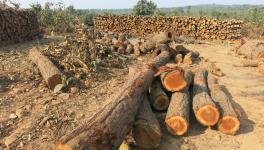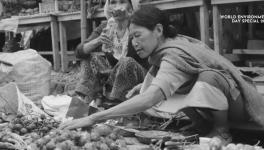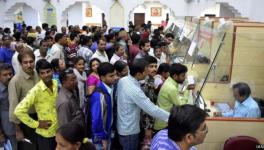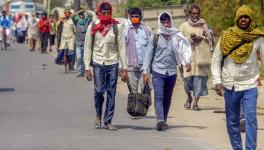UP: Pest Threat to Climate Change, Famed Malihabadi Mango Growers Face Huge Losses
Lucknow: Suraj Kumar, a mango grower in Malihabad in Lucknow district is busy spraying pesticide in the scorching heat. Usually, one needs to spray pesticide twice in an acre. But due to threat from pests, such as thrip, fruit borer and semi loopers, Kumar is being forced to spray pesticides for the seventh consecutive time.
As each spraying episode costs at least Rs 3,000, Kumar is upset that he has already spent Rs 21,000 so far. Another problem that is haunting him is that in his orchard of 98 mango trees, fruits are barely left in 10 trees, which will not give him enough produce and earnings to survive for more than two months. Three years ago, mango growing uses to be profit-making business, but that’s not the case now, at least for Kumar.
"A large proportion of crop is being damaged by these pests. The infestation starts in the fruiting stage and once the fruit is damaged or spotted, it loses market value. The mandi does not have a good market for fruit damaged by thrip and semi looper. Thrips give a shabby look to the fruit and reduce the yield,” says Kumar, who was hopeful that this time he would make good profits but the crop failure has dashed his hopes
"If the situation remains the same, neither the mango nor its growers will survive in Malihabad," he tells NewsClick.
Ram Bahadur, who could not send the fruit to overseas markets in the past two years due to the COVID-19-related restrictions, says he too was hopeful this year to earn attractive profits but his dream lies shattered by pest attacks and climate change, including soaring temperatures and reduction in rainfall.
Read Also:Gusty Winds, Rain Take Heavy Toll on Mango Crop in UP, Growers Say Output May Drop 65%
Mohammad Naseem, another mango grower in Malihabad, says he has never seen such bad mango crop in his entire life. "Thousands of mango growers of Uttar Pradesh have suffered a setback due to the destruction of crop," he says, adding that low production due to these reasons has dashed all their hopes.
Mango production has been fluctuating over the years, especially due to the vagaries of weather as well as depleting water level. “Last year, the mango crop was lower since gusty winds caused fruits to drop,” says a farmer from Ataura village of Malihabad, who has less than one bigha land.
“Aam ki kheti bas bhagwaan bharose hai, time se barish kara de, mausam theek rakhe to sab theek. (Mango farming is entirely dependent on raingods. All is well if there is timely rain and weather remains conducive).”
HIGH TEMPERATURE DENTS HOPES
Padma Shri awardee Haji Kalimullah Khan, also known as ‘Mango Man’, in UP’s Malihabad, which is famous for some of the most popular mango varieties, including Dussehri and Langda, says: “The situation is so bad this year that if there are 100 mango trees, only 10-12 bear fruits. Therefore, the cost of mangoes is expected to go up by around 60%.”
“A low produce was expected this year due to poor flowering. Poor water supply, diseases and fake pesticides are other reasons that resulted in poor flowering. Adverse weather conditions have further damaged the crop,” he adds.
According to meteorologists, this March was the hottest in the past 122 years while April was the hottest in the past 50 years. This is the first time mango farmers have experienced the impact of climate change, they say.
Insram Ali, president of All India Mango Growers' Association (AIMGA), says: "Unusually high temperatures during the flowering season in February and March this year have hit the mango crop. A maximum temperature of 30 to 35 degrees Celsius is required during the flowering season, but this year the temperature soared to 40 degrees Celsius in March itself, damaging mango flowers."
Ali says on an average, the mango belt --- Lucknow, Pratapgarh, Hardoi, Saharanpur, Barabanki and Sitapur in Uttar Pradesh -- produces 45 lakh tonnes of mangoes. But this time, following delayed flowering and other factors, including poor watering and availability of poor quality pesticide, production is expected to be lower than usual. “Besides, the crop is also late this year and is likely to hit the market in the third week of June” says Ali.
Also, low produce will also push up prices. “We don’t even have the status of a farmer. Neither is our crop insured, nor do we get any subsidy from the government on pesticides,” he adds.
In fact, UP has been experiencing high temperatures since March which is the flowering time for mangos. “Most of the mango flowers got damaged due to the unusually hot weather,” Ali says, adding “Never before has mango production been so low in the state in the past 50 years.”
Ali says he is worried about what mango farmers will do this time. “In fact, this is the season when they earn money that helps them sustain throughout the year,” he add.
Shailendra Rajan, former director, Central Institute for Subtropical Horticulture, (CISH), Lucknow, and an expert on the mango fruit, describes it a delayed flowering issue, which he says is due to low temperature. He says the scenario will not only delay the crop but will also reduce yield.
Commenting on threats of pests, Rajan says: “It has become difficult to manage these pests where mono-cropping of mango is in practice. Malihabad has mangoes covering more than 90% of the land in many places. Control of pests in one orchard becomes ineffective as insects travel from neighbouring orchards.”
Rajan believes that excessive use of pesticides has destroyed the natural control mechanism that worked through insects found in the orchards. Now, pests have developed resistance due to non-judicious use of pesticides.
The country’s major mango-growing states are UP (23.86%), Andhra Pradesh (22.14%), Karnataka (11.71%), Bihar (8.79%), Gujarat (6%), and Tamil Nadu (5.09%).
PRODUCTION DOWN 80 % DUE TO HEAT WAVE
According to the All India Mango Growers Association (AIMGA), nearly 80% production in UP has been severely hit this year due to abnormal weather conditions and unprecedented heat wave.
The AIMGA says direct impact of this will be on the price of different varieties, with each of them selling not less than Rs 70-80 per kilogramme. It says prices could even touch Rs 100 a kg as soon as naturally ripened mangoes hit the market around June 10.
"This year, the mango crop was exposed to high temperatures at the growing stage. This temperature was actually required at the stage of ripening," says Ali, adding that this will be the third year when mango growers will face losses.
In 2020 and 2021, mango exports were adversely impacted due to the pandemic and local sales were also low.
In the Malihabad area, several mango varieties are grown in 31,000 hectares.
Get the latest reports & analysis with people's perspective on Protests, movements & deep analytical videos, discussions of the current affairs in your Telegram app. Subscribe to NewsClick's Telegram channel & get Real-Time updates on stories, as they get published on our website.
























